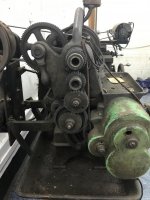MillCreekFabShop
Plastic
- Joined
- Dec 9, 2021
- Location
- Ohio, USA
I searched the forums and asked this question on other threads before starting this thread after no one responded. I have a 1919 Hendey 14X6 lathe. I started dissembling it to clean it and repaint it, and inspect everything. I have come across this part that is at the rear of the tiebar where all of the gears are. It looks like it shouldn't be like this. However, I have seen countless others that look like this too so I am unsure. Does anyone have information to share? If this isn't factory, what do you recommend for a fix? Merry Christmas as well....










